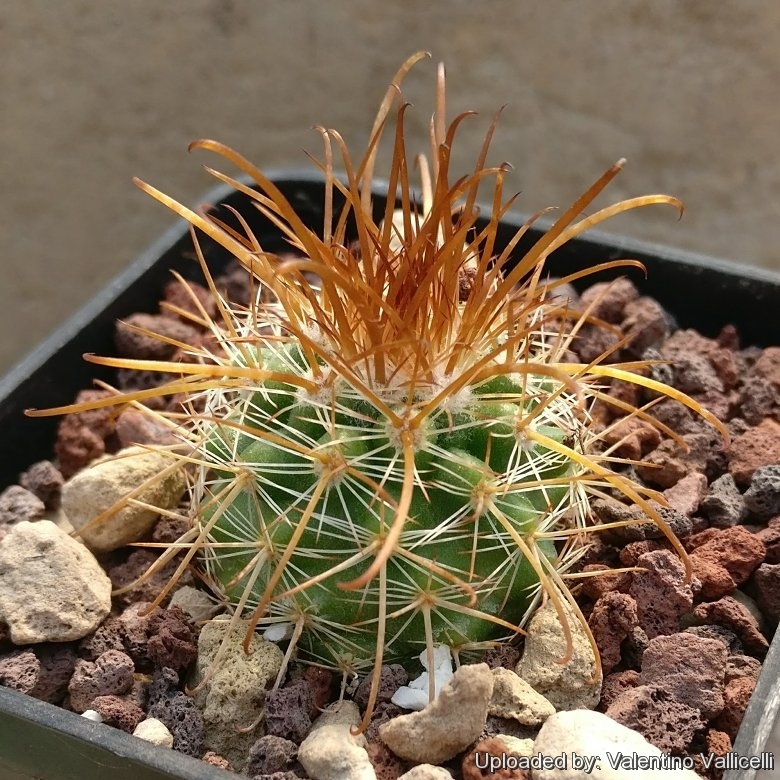Accepted Scientific Name: Parodia aureicentra var. rauschii (Backeb.) J.G.Lamb.
Cact. d'Argentine 192 (1993), without basionym ref.

Parodia rauschii (Parodia aureicentra var. rauschii) Photo by: Valentino Vallicelli
Origin and Habitat: Cachipampa to Cachi, Salta, Argentina. The growth site of Parodia aureicentraSN|11805]]SN|5760]] var. rauschii is not located in the Quebrada del Toro (as mentioned by Backeberg) nor north of the road to La Palma at a height of 3,000 meters (as reported by Haage), nor in the area where the Calchaqui River passes through the Rocks. Here, at "Angosto de Cachi", grows the related Parodia aureicentraSN|11749]]SN|5760]] var. omniaurea. The true growth site of P. rauschii is located on the edge of Cachi Adentro (Bovencachi), where it grows at a height of 2,200-2,400 metres above sea level along with the tiny Parodia kiliananaSN|5760]]SN|11749]] while P. aureicentra var. omniaurea is accompanied by the Ptiny Parodia heteracanthaSN|5760]]SN|11805]].
Synonyms:
See all synonyms of Parodia aureicentra
back
Accepted name in llifle Database:Parodia aureicentra Backeb.Cactus. Antwerp 4(4): 57. 1934 Kaktus-ABC, 268 (416). 1935Synonymy: 6
Accepted name in llifle Database:Parodia aureicentra var. rauschii (Backeb.) J.G.Lamb.Cact. d'Argentine 192 (1993), without basionym ref.Synonymy: 2
back
Description: Parodia aureicentraSN|5760]]SN|5760]] var. rauschii, best known in cultivation as Parodia rauschii, is a globular cactus, with green stem densely covered by stout, honey-yellow hooked central spines. The crown bears a mass of large red to orange red flowers in spring and, often, creamy-white wool. This species was discovered by Walter Rausch during his studies in 1962-1963. The plant was placed under the field number WR23. Rausch meant to have here to deal with a variety of Parodia aureicentraSN|5763]]SN|5760]], not wrongly by the way. It was then described in 1963 by Backeberg as Parodia rauschiiSN|5760]]SN|5763]]. In particular P. rauschii shows a strong resemblance to P. aureicentra var. omniaurea (FR 916c), a Parodia described by Ritter in 1962, which in appearance (habitus) and inflorescence is indistinguishable from P. rauschii. However the sites of origin of this two taxa are close to each other but not contiguous, and a genetic exchange seems to be excluded. But Weskamp is of the opinion that, given the differences in seed structure, there are indeed two "different" species. Compared to P. rauschii, Parodia aureicentraSN|5760]]SN|5760]] is smaller, has more marginal spines, and the the main central spine is shorter and straight (not hooked). The taxonomic value of most of this “species” and “varieties” is the subject of unfinished discussion.
Derivation of specific name: The plant was named, in honour of its discoverer the Viennese typographer and cactus hunter Walter Rausch.
Stem: Solitary, green, up to 25 cm tall and 15 cm in diameter, apex densely clothed by creamy-white to tan wool and thorns.
Ribs: About 15 spirally arranged, fairly continuous slightly narrowed between the areoles.
Radial spines. About 25, pale yellow, 10-12 mm long
Central spines: 6, stronger; 3 straight pointing upward, 2 pointing sideward, up to about 22 mm long, slightly bent, yellow to golden yellow. One (the longest) pointing downward, hooked and (30) - 100 mm long, mostly yellow to amber-yellow but also rusty yellow or in different brown tones.
Flowers: Red to orange red. Pericarpel pink, 10 mm long, 7 mm wide, completely covered with tiny red scales and long white hairs. Receptacle pink lilac, thick-walled, below about 8 mm in diameter, above up to 20 mm in diameter, 18 mm long. All the areoles bear long yellow-brown wool, a single black bristle is only preset in the highest areoles, scales are very small, far distant, red with dark tips. The tepals are orange with red central stripe, whitish at the base.
Fruit: Hollow, elongated and soft 23 mm tall, lilac pink, covered with tiny red scales and long white hairs.
Seeds: 0.8 mm long, 0.55 mm wide, the edge of the hilly area slightly arched, testa shiny black, with small round tubercles.
Subspecies, varieties, forms and cultivars of plants belonging to the Parodia aureicentra group
Bibliography: Major references and further lectures
1) Miroslav Veverka “PARODIA RAUSCHII Backeb.” retrieved from http://www.cact.cz/galerie_test/detail.php?id=423 on 17 April 2017
2) Backeberg C., “Das Kakteenlexikon”, p. 339, 347, 1966
3) Brandt F.H., Die Ritter-Parodien in "Kakteen in Südamerika" volume 2, Kakteen. und Orch.-Rundschau, 7 : 36, 1982
4) Haage W., “Kakteen von A bis Z”, p. 576, 1981
5) Hoffmann I., “Argentina - Cactus Hunter`s Paradise”; Cact. Succ. J. (US), 56 : 112, 1984
6) Hummel U., “Der Formenkreis um Parodia aureicentra” Backeberg; Kakt. und and.Sukk., 33 : 243, 1982
7) Kessler H., “Die FR-Parodien”; Stachelpost, 8 : 319-320, 1971
8) Piltz B. et J., “In den Anden Argentiniens”; Kakt. und and. Sukk., 29 : 81-82, 1978
9) Ritter F., “Parodia aureicentra Backeb.”, Cactus (Paris), 75 : 22-24, 1962
10) Ritter F., “Kakteen in Südamerika”, 2 : 422-424, 1980
11) Weskamp W., “Die Gattung Parodia Spegazzini”; Kakt. und and. Sukk., 24 : 104, 1973
12) Weskamp W., “Die Parodien in Nord-Argentinien”; tamtéž, 32 : 218-219, 1981
13) Weskamp W., “Was ist Parodia kilianana”; tamtéž, 35 : 215, 1984
14) Weskamp W., “Die Gattung Parodia”, p. 89-92, 268-269, 1987
Cultivation and Propagation: Parodia aureicentra var. rauschii is a rare species in collections, perhaps because it grows slowly and is tricky. Water these plants regularly, and fertilize with a low nitrogen fertilizer ¼ strength every 6 to 8 weeks, from mid-spring to late summer. This plant should remain rather dry at other times (especially in winter), except for a quick, periodic misting on warmer days in late winter. If it is kept absolutely dry for a long period, it tends to lose its roots in winter. It require dry, sunny and warm hibernation ((10-15 degrees C).), but rots easily if wet and cold.
If the local climate is warm enough to grow this plant outside, be sure that soil is well drained and sun if full, but with protection from strong midday rays.
Propagation: By Seeds that are very fine. Patience is required when growing various Parodia species from their small, slowly germinating seeds, some of which take as many as two years to germinate.











